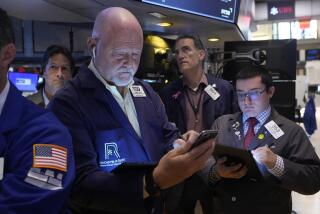Stocks Plumet as Dollar Reels : Yen at Record Level Despite Bankâs Efforts
TOKYO â Reacting to rising tensions in U.S.-Japan economic relations, the dollar Monday plunged to another all-time low against the yen on the Tokyo Foreign Exchange Market despite heavy intervention by the Bank of Japan.
In less than 30 minutes of trading, the dollar fell to 144.70 yen, down 4.3 points from Fridayâs close of 149 yen. The Bank of Japan bought about $2-billion worth of dollars in a vain attempt to halt the decline.
Although the dollar recovered on its own without central bank intervention in the afternoon, it finished trading at 146.20 yen, a new low for a closing price. Its one-day loss amounted to 1.9% in $9.8-billion worth of trading.
Cites Fears
Finance Minister Kiichi Miyazawa said for the first time that fears of a âfree fallâ of the dollar had emerged.
âThe (U.S.) Federal Reserve Bank is beginning to worry about that. I think the other countries are engaging in a broad-scale intervention because there is that fear,â Miyazawa told a news conference.
Continuing the intervention may cool down speculators but, the finance minister said, he does not want to decide what actions should be taken on the basis of trading during âa day or two.â
âI would like to watch conditions a little longerâ before considering any appeal to other advanced nations for new action to stabilize exchange marts, Miyazawa said.
âIf this condition continues for long, it would be extremely undesirable,â he added.
Traders here also expressed fears about a global collapse of the dollar. Some economists said that only an increase in interest rates in the United States could reverse the dollarâs decline.
Isamu Miyazaki, head of the Daiwa Securities Research Institute, said that exchange movements have come to center on the dollar, not the yen, as the chief problem. He predicted, however, that fears of the dollarâs collapse would halt its decline soon.
âIt is inconceivable that a free fall of the dollar would occur,â said Miyazaki, a former government economist.
Tensions Over Tariffs
New tensions in U.S.-Japan economic relations caused by President Reaganâs decision Friday to impose retaliatory tariffs on Japanese electronics goods are believed to have convinced dealers that overall trade with the United States is approaching a crisis stage.
Only a stronger yen, which would drive down earnings of Japanese exporters and make sales of all products to the United States more difficult, would ease frictions with Washington, they reasoned.
The dumping of dollars in Tokyo, however, paralleled a sell-off by Japanese institutional investors of large holdings of U.S. Treasury bonds, which temporarily raised yields by 0.17% to 7.82% on 30-year Treasury notes in the Tokyo dollar-denominated bond market.
Shifting Holdings
Tsunazo Nishimoto, head of Meiji Life Insuranceâs international investment department, said Japanese insurance firms and investment trusts were shifting their holdings of dollar investments into other currencies out of a fear of further weakening of the dollarâs value.
In the last 12 months, insurance companies were estimated to have lost 1 trillion yen ($6.8 billion at Mondayâs closing exchange rate) in their dollar investments because of the decline in the value of the U.S. currency. Twenty-three insurance firms alone held about $23-billion worth of dollar-denominated bonds at the end of 1986.
Japanese investors were reported to have bought about a third of the new 30-year Treasury bonds issued in February in the United States, but last week bought only 10% of newly issued seven-year Treasury bonds.
New Policy Urged
The leap in the yenâs value, combined with the first retaliatory move against Japanese imports into the United States for Japanâs alleged failure to uphold a U.S.-Japan semiconductor agreement signed last Sept. 2, brought new calls for Japan to resolve all of its pending trade disputes with the United States, as well as adopt quickly a new policy to promote growth at home.
Except for saying that Japan will announce âlarge-scaleâ economic measures after Parliament enacts the fiscal 1987 budget, Prime Minister Yasuhiro Nakasone, however, remained noncommittal. He told the budget committee of the lower house of Parliament only that he intends to explain Japanâs âtrue intentionsâ and âprop up cooperative relationsâ when he visits Washington April 29 to May 5.
Shigeo Muraoka, trade policy director of the Ministry of International Trade and Industry, said Japan would ask the United States formally in Washington for emergency consultations on the semiconductor agreement. The request was made later in the day in Washington.
Muraoka, however, said Japan would use the consultations only to seek withdrawal or postponement of Reaganâs decision to impose $300-million worth of tariffs on Japanese electronic goods and reiterate its position that Japan has faithfully upheld the agreement.
U.S. âVery Frustratedâ
The trade official acknowledged that Reaganâs decision to impose 100% retaliatory tariffs was a âmanifestation that the United States is very frustrated. I think the fact that trade hasnât improved despite the big change that has occurred in exchange rates has made the U.S. government and Congress very irritated.â
He too called for Japan to implement bold measures to spur domestic growth and pull in imports. For its part, Muraoka added, the United States should carry out its promises to restore competitiveness to American industry and reduce its budget deficit.
Muraoka did not repeat the threat that his minister, Hajime Tamura, made Saturday of possible Japanese retaliation against Reaganâs decision. Tamura had said that Japan would âconsiderâ rescinding all or part of the semiconductor agreement if Reagan implemented the 100% tariffs April 17, as now planned.
No other Japanese official has repeated Tamuraâs threat.
Paris Agreement
Only 36 days ago, the financial leaders of the United States, Japan, Britain, France, West Germany and Canada agreed in Paris to halt the dollarâs decline and stabilize exchange rates that prevailed then. Specifically, Nakasone confirmed publicly for the first time Monday, the agreement was to hold the dollar above 150 yen.
Mondayâs trading in Tokyo, however, brought down the dollarâs value 4.9% compared to the level of 153.77 yen that prevailed immediately before the Feb. 22 meeting.
Since September, 1985, when financial leaders of the same countries, excluding Canada, agreed to lower the dollarâs value, the yen had appreciated by 65.5% at the end of trading Monday.
In London trading Monday, the dollar also fell against the British pound, which cost $1.6095, compared to $1.6030 late Friday. Other late dollar rates in Europe, compared to late Friday, were: 1.8015 West German marks, down from 1.8240; 1.5040 Swiss francs, down from 1.5210; 6.0025 French francs, down from 6.0620; 1,284.75 Italian lire, down from 1,297.50.
In New York trading, the dollar fared a little better against the pound, which slipped by a fraction to close at $1.6076, down from Fridayâs $1.6080. But it did no better against the other West European currencies than it had in London: A dollar bought 1.7985 West German marks, down from 1.8160 Friday; 1.4995 Swiss francs, down from 1.5130; 5.9995 French francs, down from 6.0435, and 1,282.50 Italian lire, down from 1,294.20.
More to Read
Inside the business of entertainment
The Wide Shot brings you news, analysis and insights on everything from streaming wars to production â and what it all means for the future.
You may occasionally receive promotional content from the Los Angeles Times.










